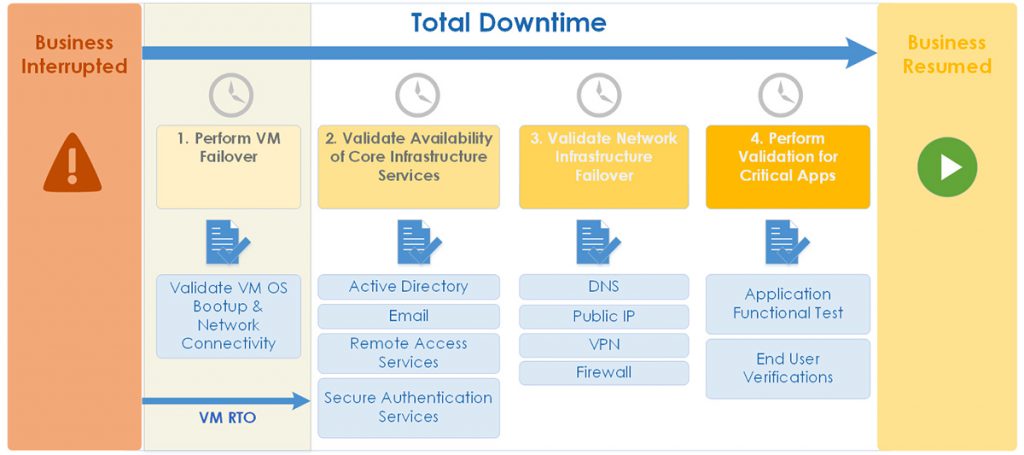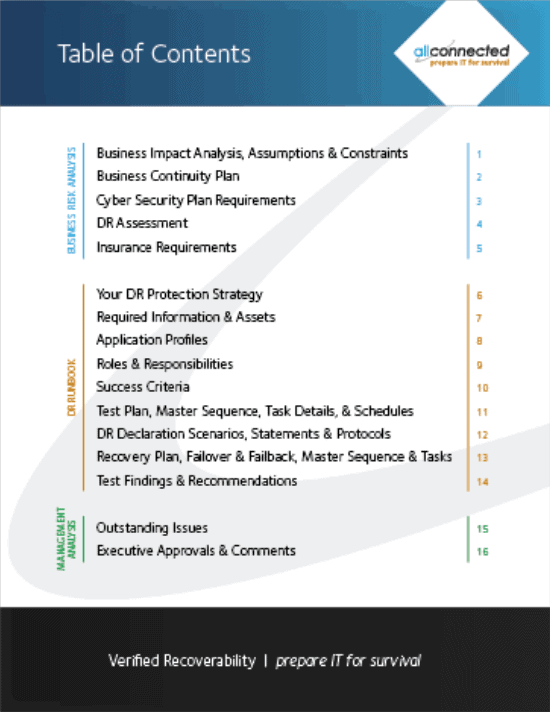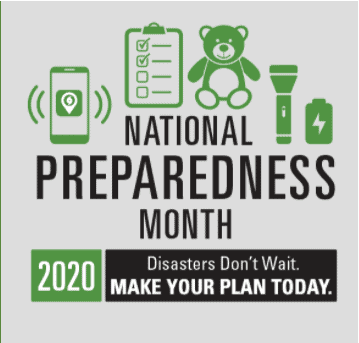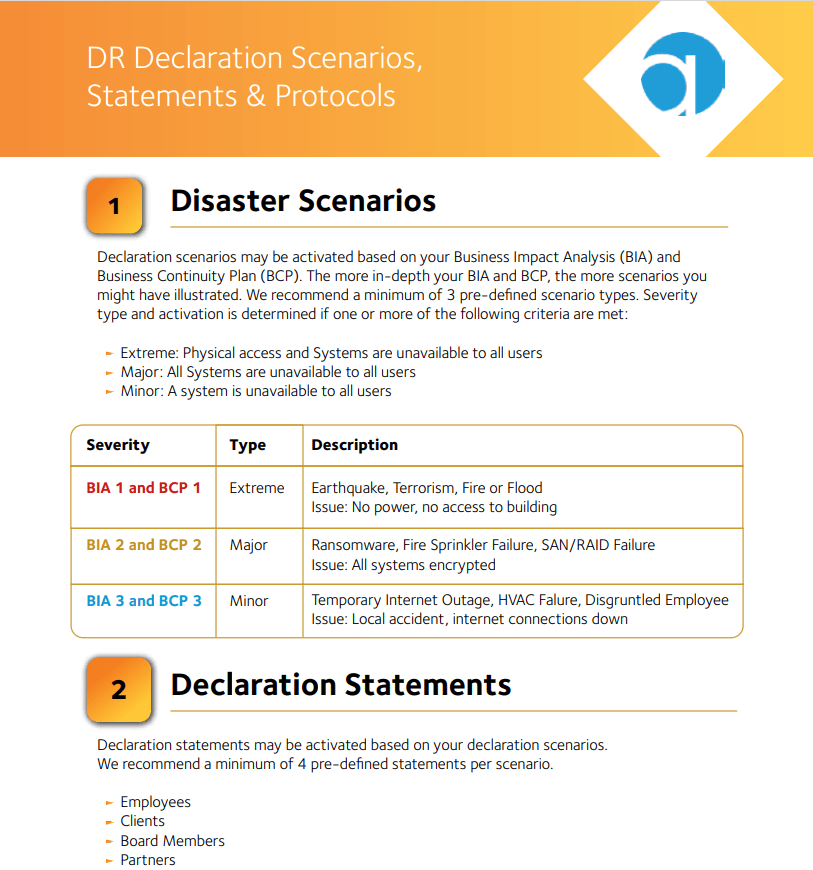Disasters Don't Wait. Make Your Plan Today
National Preparedness Month 2020
The theme for National Preparedness Month 2020 is
“Disasters Don’t Wait. Make Your Plan Today.”
The NPM goal is to ‘promote family and community disaster planning now and throughout the year’. As we continue to respond to COVID-19, there is no better time to be involved this September.
Most organizations have made significant changes recently to the way our employees work and how they access infrastructure. Whenever changes in infrastructure occur, and at least annually, organizations such as NPM and FEMA urge businesses to review and test their disaster recovery plan. Doing so helps us to prepare for a potential disasters and ensure business continuity the primary site is unavailable or if your staff needs to work from home.
After all, in 2020 we have all battled through a worldwide pandemic, fires, power outages and civil unrest. Other disasters could also impact our community, whether man-made or natural, so we need to prepare.
Having a well thought out plan that both you and your family have practiced can be vital for your survival. For expanded documentation and support for families, go to https://www.ready.gov/september
How can you get started? Below are the steps that organizations and your employee’s families are encouraged to follow to ensure we are prepared. What are they?
Teach Youth About Preparedness | Week 4
Families:
Talk to your kids about preparing for emergencies and what to do in case you are separated. Reassure them by providing information about how they can get involved.
Organizations:
Share your DR strategy with your employees and include them in the process of Disaster Recovery (DR) and Business Continuity (BC).
Do all your employees know how to react in an emergency, whether it is during work hours or not?
You may already have a dedicated DR team that is fully staffed and prepared, but they not be readily available in an emergency. If other employees may need to temporarily assume unassigned roles or responsibilities, it’s best that they receive some preparation.
Make sure they have access to your DR Runbook along with up-to-date contact information, and encourage them to provide updates and suggestions. An extra set of eyes may see what your IT staff overlooks.
Your business continuity plan should also include scenarios for staff members unable to come into the office. The 2020 COVID crisis caught many organizations flatfooted. Some companies successfully implemented ad-hoc solutions, but still need an effective long-term remote work strategy.
AllConnected’s Disaster Recovery team is constantly improving our DR Runbook templates for clients. The latest section update is DR Declaration Scenarios, Statements and Protocols.
Your company should also document the policies and activities that will be most important to your employees, including policies for sick leave, flex time and remote access.
Including your whole staff in DR/BC planning is not only important for employee empowerment in case of an emergency, but it also supports team building and succession planning.
When every employee is committed to DR/BC planning, your company’s plan has the best chance of success.
Prepare for Disasters | Week 3
Families:
Limit the impacts that disasters have on you and your family. Know the risk of disasters in your area and check your insurance coverage. Learn how to make your home stronger in the face of storms and other common hazards and act fast if you receive a local warning or alert.
Organizations:
Preparing for disasters means testing. Without testing, even the best DR plan is just wishful thinking.
Proactive tests not only uncover unaddressed risks but also increase the speed and effectiveness of data recovery. They should be run regularly, especially for systems that have undergone updates or configuration changes. Read more
Not sure if you’re ready to test your DR plan? Feel free to test your readiness level through our online Assessment tool: Level-Up Your Disaster Recovery Plan: Prepare with Our Assessment Tool
To run a successful DR test, be sure to answer the following questions:
- What are the most likely disasters to impact your business? Are you testing scenarios uniquely suited to your situation? How do you define a successful test?
- Are you testing scenarios uniquely suited to your situation? How do you define a successful test? What goals and success criteria are you using to rate your DR strategy?

Will your DR test pull active systems offline? Are these systems backed up in case the test fails?
- Who is involved in the DR test? Are they the same people responsible for those roles during a real emergency?
- What systems does your DR test include? Will all forms of infrastructure be taken into account?
- How involved with management be before, during, and after your DR test?
If you have questions or struggle with effective DR testing, AllConnected can help.
Build A Kit | Week 2
Families:
Gather supplies that will last for several days after a disaster for everyone living in your home. Don’t forget to consider the unique needs each person or pet may have in case you have to evacuate quickly. Update your kits and supplies based on recommendations by the Centers for Disease Control.
Organizations:
If you’re having trouble developing your DR plan from week 1, click: Level-Up Your Disaster Recovery Plan: Prepare with Our Assessment Tool. We developed it to help you move your disaster recovery conversations forward.
To “build your kit”, we recommend assembling or updating your DR failover/failback process.
In other words, if you do not have a co-location (colo), consider getting one. Co-location facilities store equipment used by their clients, and provide power, cooling, space, bandwidth, and physical security for the equipment. An offsite colo datacenter enables your company to establish off-site backups. Be sure to consider backup and recovery processes for your cloud-based applications, such as Microsoft Office 365.
In an emergency that makes your data inaccessible or your primary site unavailable, a colo enables you to automatically “failover” your network resources to keep your company functioning, or quickly recover critical data.
Co-locations can be expensive, so to set up or optimize your DR plan, you may need an MSP like AllConnected. We offer private and hybrid cloud data center resources in Simi Valley, Las Vegas, and the East Coast, and can work with your IT team to harden your network for security and high availability.
Make A Plan | Week 1
Families:
Talk to your friends and family about how you will communicate before, during, and after a disaster. Make sure to update your plan based on the Centers for Disease Control recommendations due to the coronavirus.
Organizations:
If you haven’t created a Disaster Recovery plan (DRP), now is the time to start.
Your DRP is a comprehensive statement of consistent actions to be taken before, during and after a disaster. Your DRP is an active, ongoing process to protect your IT infrastructure, which should be revisited after every new product launch, corporate acquisition or system development.
While every company is different, a DR Runbook should include:
- An Overview to explain your disaster recovery methodology
- A list of your organization’s hardware, software and databases along with which team members are responsible for their maintenance
- A table of your organization’s contacts with cell phone numbers
- A list of the possible alerts for a particular service, along with instructions on what to do and who to contact
- Instructions on how to deploy the software and build a server from scratch
If your company has not begun, creating a DRP can be a daunting task. AllConnected can help your organization get started with our customized DR Runbook template. Contact us for one today!



